Jenson Button: The Motor Sport Interview
The 2009 F1 champion rarely ducks a challenge, which is why his CV includes rallycross, car development and punditry. As he tells us, there are still some invitations he’d find hard to turn down
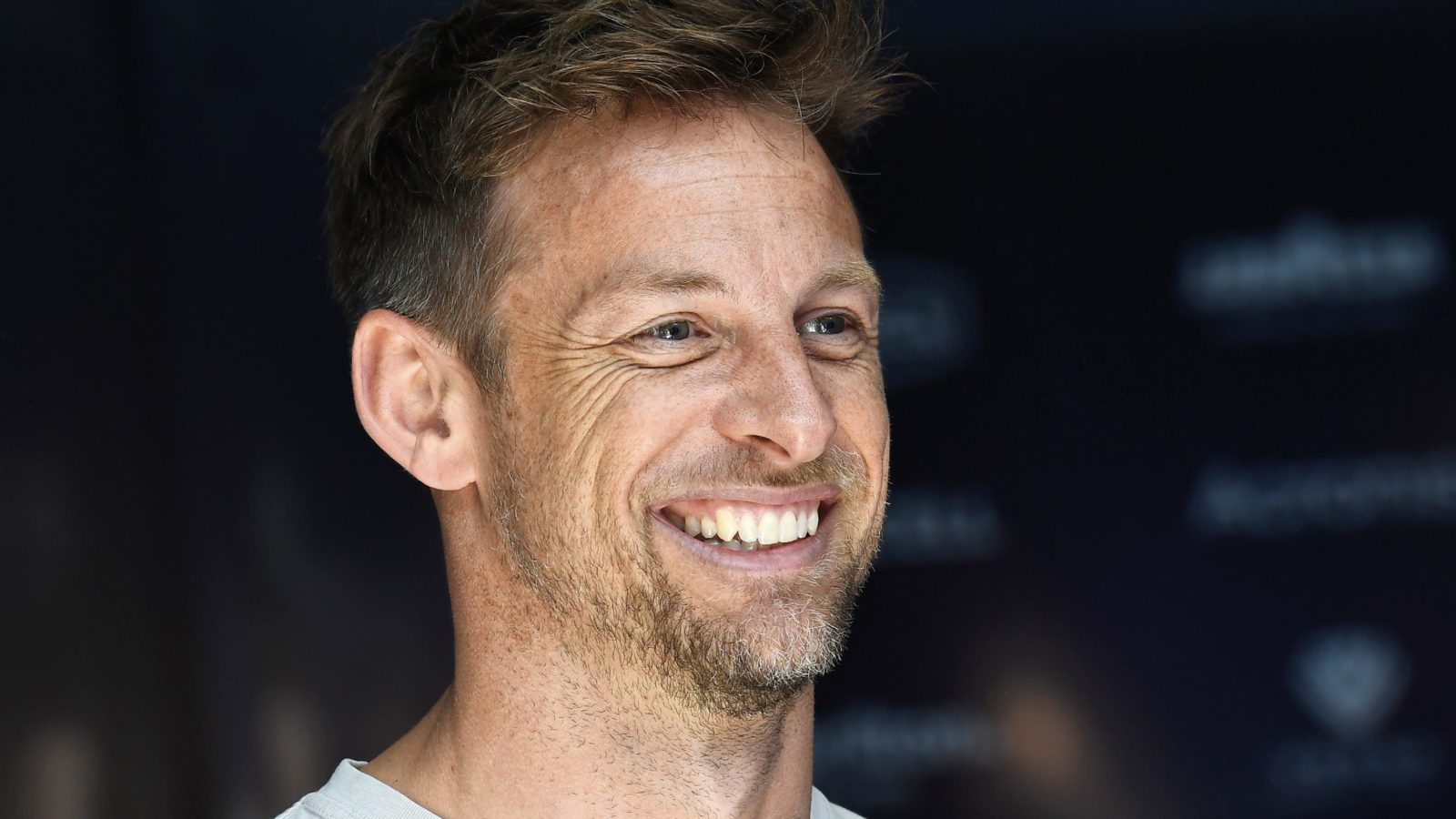
GRAND PRIX PHOTO
Jenson Button MBE, or ‘JB’ as he’s known on Planet F1, did not have a job in the winter of 2008. A year later he was world champion, having won six of the first seven races of the 2009 season. His team, Brawn GP, won the constructors’ title in its first and only year in the sport. You simply could not make this up, a momentous and unique achievement that’s a chapter of its own in motor racing history.
The boy from Frome, who began as a kart racer for fun, is now ‘retired’, living in Los Angeles and busier than he’s ever been. A quick summary of what keeps this man busy includes JBXE, his Extreme E team, Nitro Rallycross in the USA, the renaissance of Radford cars, Team Rocket with ambitions of a Le Mans car, Sky TV punditry and a newly discovered love of racing historic cars. He’s a hard man to pin down but Motor Sport caught up with him between transatlantic flights, ‘Button International Inc’ business meetings and grands prix on Sky. The topics, as you might expect, are many and varied.
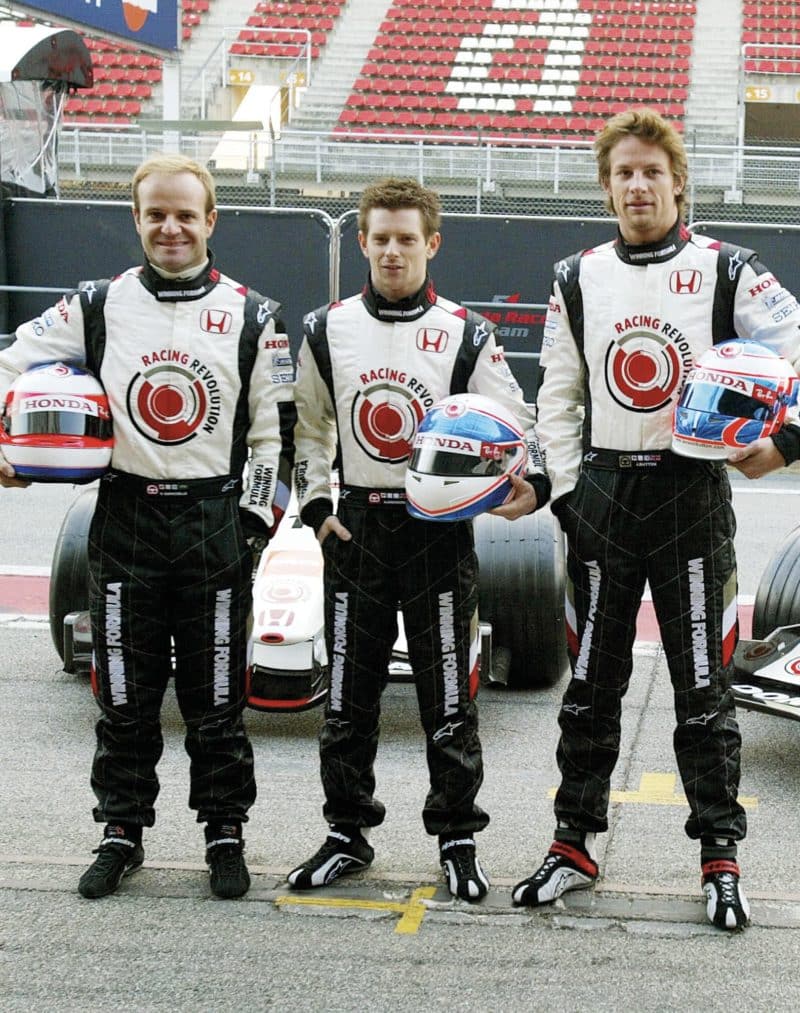
2006 Honda F1 drivers (from left) Rubens Barrichello, test driver Anthony Davidson and Jenson Button
Getty Images
Motor Sport: Like so many F1 drivers you honed your skills in karting and your father spent a lot of time developing your talent.
JB: “Yes, he did. He was such a great ‘racing dad’ because he was never pushy, not forceful at all. I felt lucky that I was going kart racing in the first place. I mean I was just this kid from Frome in Somerset and I never thought I’d have this opportunity. I always enjoyed it but then as a teenager I was changing a lot mentally, going through all the stuff you do at that time. I really didn’t have my eye on the ball, and I was struggling to focus on the racing. There were a lot of other things going on. I was missing out at school, I was missing my mates. So, you know, my performances just weren’t happening.
“I heard Dad tell my mum, ‘I don’t think he’s got what it takes’“
“One day, on the way home in our van, Dad thought I was asleep and I heard him tell my mum, ‘I don’t think he’s got what it takes, the extra bit that’s needed.’ I didn’t tell him I’d heard that until I won the world championship in Brazil in 2009. He was devastated, cried his eyes out, but what he’d said definitely helped me in my career. To my face, Dad had always said, ‘You know what, if karting isn’t what you want to do right now we can take a break from it or stop.’
“That’s what I needed because I wasn’t the kind of kid who would do well if I was pressurised to do something. So yes, Dad was very supportive, and it was great to enjoy the journey with him until he passed away in 2014. Racing just wasn’t the same after that and I’m sure he would have loved to see me race these great classic cars like the AC Cobra and the E-type Jaguar.”
Anthony Davidson, who was your rival in karting, told me he was impressed how fast you were in the wet from the start.
JB: “Ha! Yes, the way I drove, I always felt everything through my hips and my bum, so it wasn’t just with my eyes. It was the feel of what the car was doing. A lot of that came from when I was first learning to race. My dad didn’t buy me wet tyres. He couldn’t afford them and thought it would be good for me to learn to drive on slicks in the rain. So, early on, I learnt how to feel really unstable karts in the wet and that was a great lesson which stuck with me for ever. Track conditions where you have to feel where the grip is, those were always my strongest races, when you’re not just looking at the track, and the grip level is not consistent, always moving.
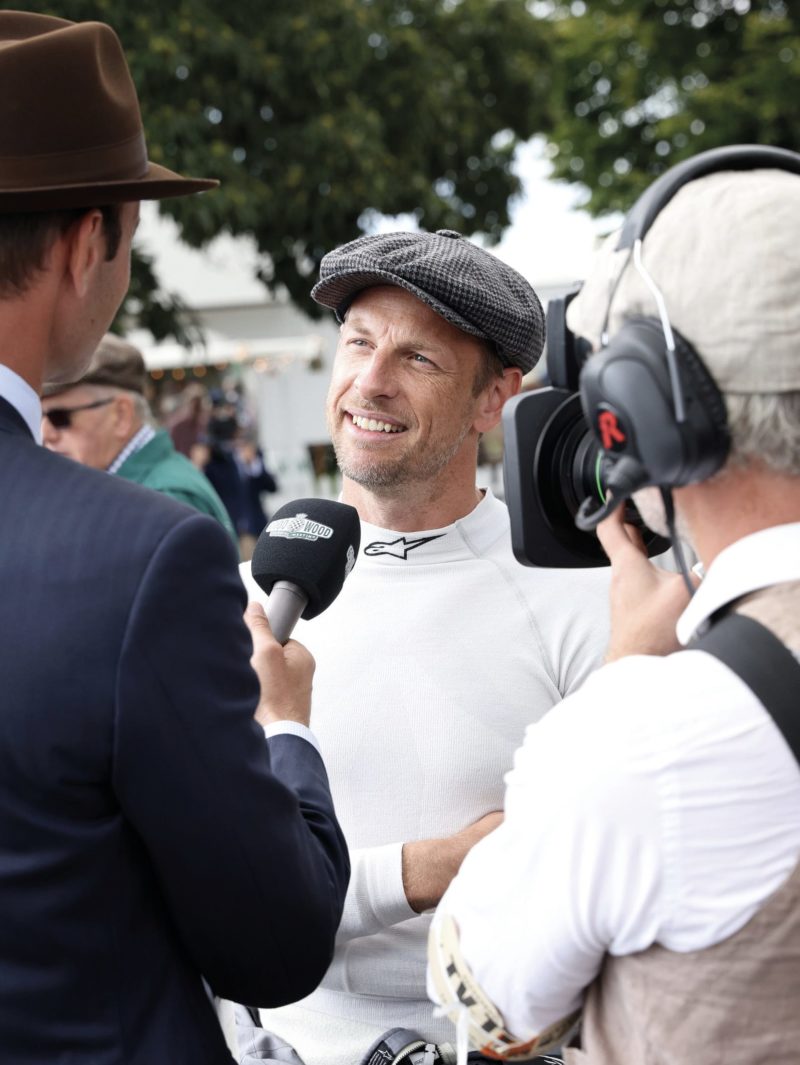
The baker boy hat is on for the Goodwood Revival in September
MATT ALEXANDER/PA WIRE
“That’s what helped me when I won that crazy Canadian Grand Prix in mixed conditions in Montreal, and at other races. I’m hoping it carries over to Nitro Rallycross in America. I will have 1000bhp from an electric car on the dirt… with gap jumps… It’s nuts but I’m excited by a new challenge ahead. Rallycross is something my dad used to race back in the 1970s so that’s nice for me. It’s another challenge and it’s going to take a while for me to learn a new type of driving on the dirt. We’ll see how it goes.”
Why did you stop driving for your Extreme E team after just one race?
JB: “Well, I really scared myself a lot in that first race, and then I couldn’t do the second because of other commitments. It’s worked out OK because Kevin Hansen got in the car and did such a great job. He’s a rallycross racer, so it’s his world. Kevin has stayed with the team so it’s probably better that he races the car.
“It’s been a big learning experience. They’ve been great, learning very quickly, especially the engineers, and they’re really enjoying the process in Extreme E. So I won’t be jumping back in the car again.”
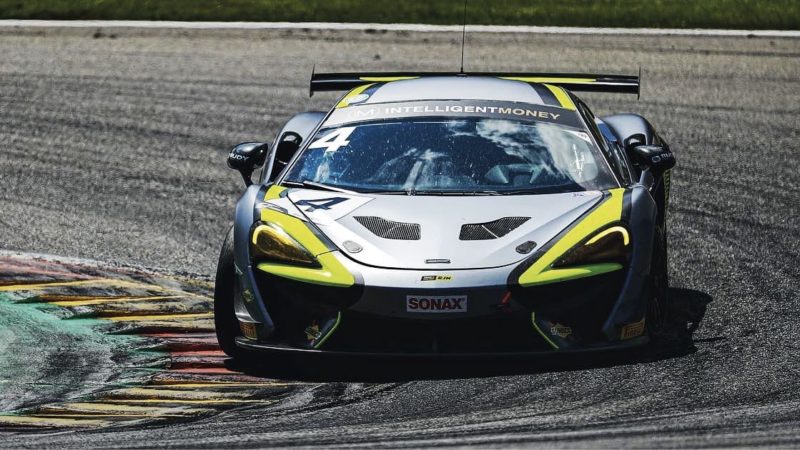
Jenson Team Rocket’s McLaren in 2021’s British GT Championship
MATT ALEXANDER/PA WIRE
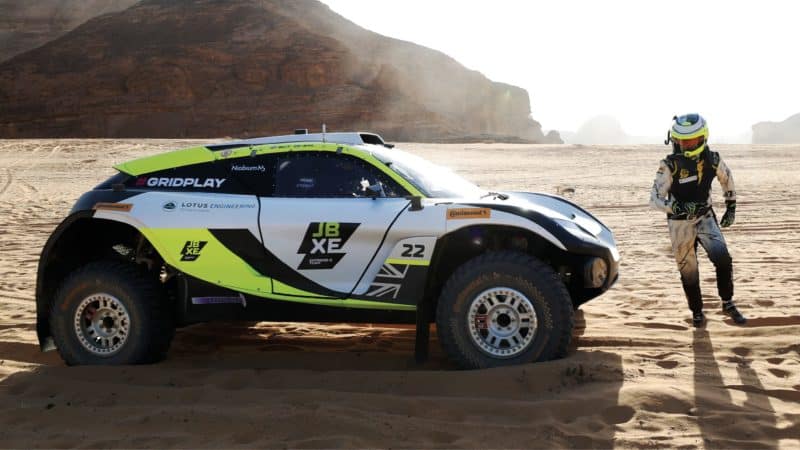
Button raced just once for his JBXE team in Extreme E – the Desert X-Prix in Saudi Arabia
AFP VIA GETTY IMAGES
What’s happening with Team Rocket, a part of the ‘Button heritage’ and originally set up by your dad?
JB: “The guys are doing British GT at the moment. We obviously always want something bigger and to race in Europe. GT4 is a really fun category, but GT3 is unbelievably competitive between the big manufacturers so it’s tricky. Our mechanics and engineers are some of the best in the world and our dream is for Rocket to race at Le Mans.
“We had this dream before it became GT3, which it’s going to be in 2024, so it’s all about getting a slot on the grid and that has to be our aim for the future. I might be too old to race myself by then. We’ll see… Maybe. It’s fun to learn new things and GTs are very different to what I’m used to. But then I’d never raced a historic car before Goodwood in 2021 and I loved that, even though those cars are the complete opposite of a Formula 1 car. There’s no downforce, no electronics, so yes, maybe GT3 will be the way forward for us in WEC.”
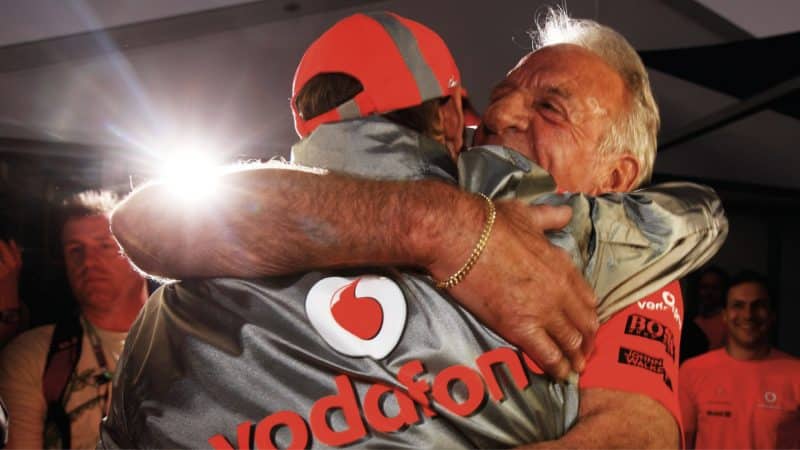
Hug for dad John after winning the 2012 Australian Grand Prix
AFP VIA GETTY IMAGES
Tell me about your involvement with Radford. Why did you take on this project?
JB: “They were reviving the brand, talking to Lotus about a new generation Radford, and I thought this sounded like a great opportunity for me to contribute. It’s been a long road, lots of ups and downs, but really enjoyable, and being involved right from the beginning has been great. It’s a Lotus chassis but everything else is completely different. We’ve used the Lotus engine block but developed all the internals to produce 604bhp from a 3-litre V6. It drives superbly. The power range is great with the supercharger.
“Everything is custom fitted, the R53 suspension, Dymag wheels, and former Red Bull engineers at Rock Engineering have made the subframe. It’s an exciting project. There’s still work to be done. I’m still developing the car. I drove it at Laguna Seca recently which was fun. Lots of fast flowing corners. A weight of 1000kg and 600bhp should feel good, and it does. It’s properly quick. We’re lucky, we can keep developing, and the customers understand that. If there’s something we want to tweak, we get the car back and we tweak it for them. They’re enjoying the process of being involved in developing a new Radford. It’s a good relationship.”

Involvement with the Radford Lotus Type 62-2 has been enjoyable
Radford
You keep saying you are a retired racing driver but you seem to be busier than ever, involved in so many things.
JB: “Yes, I am doing a lot of stuff. My wife keeps telling me I’m doing too much, that I’m not at home enough, but if the right opportunity comes along I will race in something. I’d love to do Le Mans, and NASCAR, so if they come along I’ll take it.
“I was going to do an IndyCar test with McLaren a couple of years ago but it never happened because of travelling during the pandemic and the Covid bubbles. That’s in the past – I don’t think I’d be interested now. Problem is, as soon I get these chances then everything becomes very serious which is probably why I’ve waited this long to find what really works for me. When I go racing I’m all in, I do it properly, and doing it seriously takes all my energy. I was 36 when I left Formula 1. I felt old then, but that’s five years younger than Fernando [Alonso] will be at the end of the year.
“It’s nuts isn’t it? But if you’ve still got the want, and the fitness, you can still be competitive in your forties, and that’s great.”
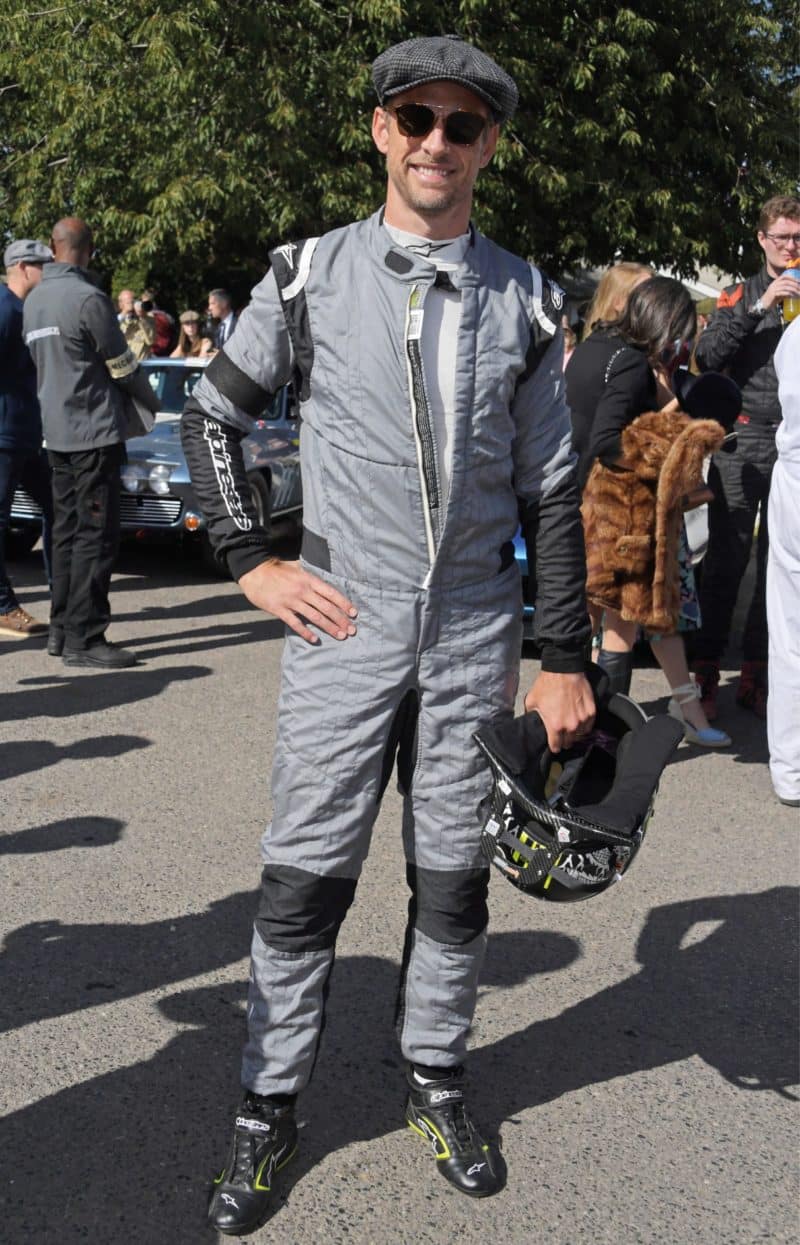
Button at the Goodwood Revival in summer, with the sort of smile you have when racing a Cobra
Getty Images
You must relate to the musical chairs we saw in F1 this year because when you wanted to break your BAR contract and go to Williams it was disallowed.
JB: “Yes, that’s true, but if you’re referring to [Oscar] Piastri, I wasn’t in my first year, never having raced an F1 car before at the time, so it was a different situation. I wanted to leave BAR and go to Williams because they were the works BMW team at the time and BAR didn’t have a manufacturer partner. For my career, I thought being with a manufacturer was the best thing, but I couldn’t get out of the contract. The next year I did have a contract to race with Williams but then BMW decided to leave Williams and have their own team. So now, suddenly, I didn’t have what I wanted any more and then BAR became Honda so I had to do a U-turn and stay with BAR which meant paying Frank [Williams] a healthy amount of cash. It was the right decision and worked out well in the end.
“With Piastri, it was a shame because it was the Alpine young driver programme that gave him his opportunity. They must have pumped millions into it, given him many days of testing, getting him ready, fully prepared for F1. So I understood why Alpine was hurt by it all, and jumping ship to another team may not have helped Piastri’s reputation. He’s going to be under pressure to perform.”
On top of everything else you’ve joined the Sky F1 crew as a motor racing pundit. What is it like on the other side of the fence?
JB: “Well, I’m working with some great people. The Sky team is fantastic. I really enjoy working alongside Simon Lazenby – he does such a great job. For me, it’s important still to be current because I work with different partners and sponsors all round the world so it helps being on the punditry panel and doing some commentary. It’s also fun. There’s massive adrenaline, you’re watching the racing and immediately commentating on it. That’s a big buzz – really enjoyable.
“My wife keeps telling me I’m doing too much, I’m not home enough“
“I remember the first time I interviewed the drivers after the race. It was weird. I’m talking to guys I raced against for many years and they’re thinking, ‘Wow, it’s you – I’m going to get some tough questions now!’ I think they open up a little bit more when it’s me asking the questions because I’ve been there, done it, been through good times and tough times. I know when they’re not telling the truth, so that’s always good.
“I went through a period of my career when I just stopped talking because everything I said was taken out of context and used in the wrong way. It was mainly certain Fleet Street journalists and that doesn’t seem to be so much the case these days. Anyway, I just shut down to deal with it and answered questions in the simplest way, which is a shame because you lose your personality. The sport should be all about personalities. That’s why people love Drive to Survive on Netflix. It’s all about the characters, the individuals in Formula 1. Once they’ve got their crash helmets on you’re just watching the racing but when you see them out of the cars and hear them speaking, then you start supporting a driver because of who they are, not just because of their skill.”
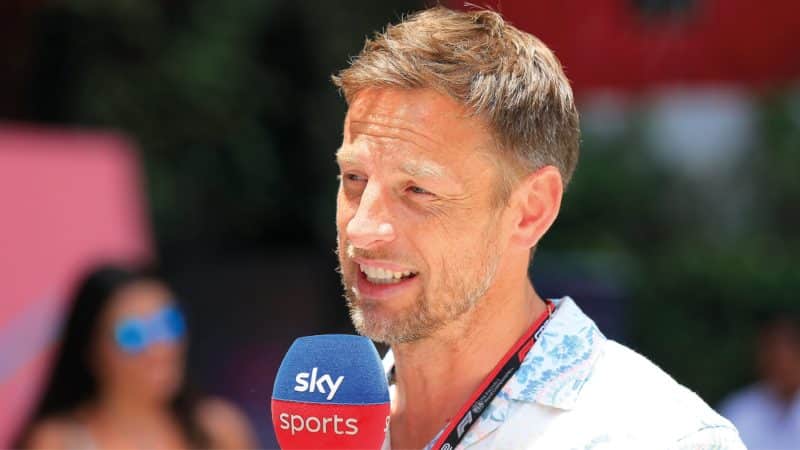
Punditry with Sky F1
DAVE BENETT/GETTY IMAGES
What’s your take on Daniel Ricciardo’s situation at McLaren this season? Can you relate to what’s going on?
JB: “I can, yes, because I always wanted a car that was designed, or set up, to suit my particular driving style. Daniel found that he couldn’t brake and turn in with the McLaren – he was needing to brake in a straight line and then turn in. He was unable to match, or beat, a team-mate [Lando Norris] who’s very quick, and that’s the worst thing for a driver.
“He’s lost some confidence but he hasn’t suddenly forgotten how to drive a racing car. It’s just a shame he hasn’t found a way round the problems despite a regulation change which can be an opportunity for a driver to have input into the design of the car. He needed a change of scenery to find a way out of the slump he’s been in.
“We all still love Daniel Ricciardo. He still has a lot of fans out there even though he has been outperformed by his team-mate. I had similar problems with the BAR in 2008. The car was bad anyway, and it went in a direction that really didn’t work for me, so that was my most difficult year. I struggled a bit in 2001 but that was inexperience, not understanding how to set up a Formula 1 car.”
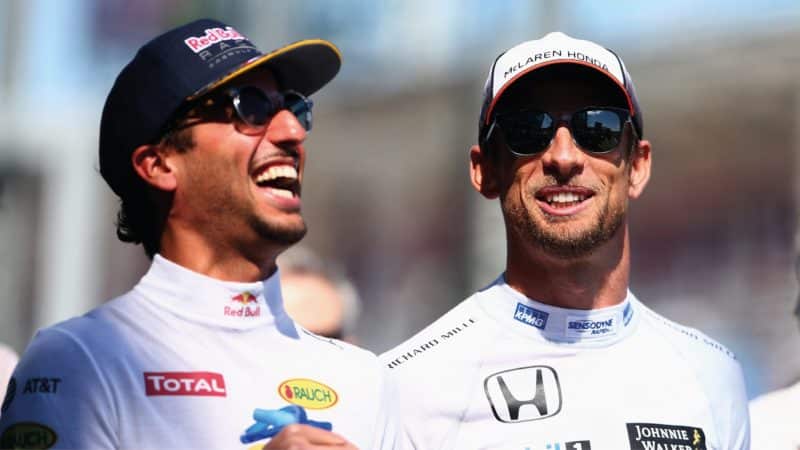
Happier times for Daniel Ricciardo, with Button, 2016
Getty Images
You wowed the crowd with your debut at Goodwood Revival in an E-type and an AC Cobra in 2021. It seems you love the challenge of these historic cars?
JB: “Goodwood is so much fun, seeing those beautiful E-type Jaguars, the Cobras, the Ford GT40s, none of which I saw as a kid because it was before my time. To see them race in anger now, it’s pretty spectacular. This year I had the chance to race Adrian Newey’s lightweight E-type which was great because I’ve always raced against Adrian’s Formula 1 cars, and sharing with his son Harrison made it even better.
“I went from first gear to fourth and the Cobra still pulled away“
“Last year in the Cobra I wasn’t used to the car and I fluffed the start because the cars next to me, with their exhausts coming out of the side, made so much noise that I couldn’t hear anything! So I went from first gear to fourth and, because a Cobra has so much torque, it still pulled away… and then I realised, found second gear, but lost a lot of ground. It was fun because I had a great race coming back through the field to third. It’s something different. I love the cars and I tell you, the competition is fierce. Driving them, you feel everything underneath you, a real connection to the road, and you kind of dance them through the corners, holding the slide.
“It’s all about balancing on the throttle, balancing on the brakes, through the steering wheel and dancing on the pedals. It’s a juggling act all the way round.
“At the end of a straight at close to 150mph you have to brake really early. The corner seems miles away, but leave it any later and you won’t stop. People think it’s all about power with a Cobra but it’s not – it’s about traction, getting that power down. Unlike a modern car you can’t just plant the throttle and then it does everything for you. You feed the power in gently and be gentle on the clutch in the gearchanges, or you’ll have wheelspin all the way down the straight.
“There’s no technology to iron out all the wheelspin. It’s all properly mechanical, and I like that. More and more top drivers are hearing good things, thinking, ‘Hey let’s give historics a go,’ and then coming to Goodwood, which is fantastic for the fans.”
You have a C-type Jaguar in the Button collection. Tell me about the history of this car which you plan to race.
JB: “This was actually Juan Manuel Fangio’s road car so it didn’t race in period although it was raced a lot in the last couple of decades. When Fangio was racing for Ferrari he saw the C-type at a car show and said, ‘I want that.’
“He sold it after a couple of years. He had to because as a works Ferrari driver they didn’t want him in a Jaguar. It’s been raced by my friend Alex Buncombe. He won in Monaco and at Le Mans.
“We wanted to race it this year but we’ve had the engine out and there’s still a lot of work needed to be done to get it ready, so we’ll be out next year.”
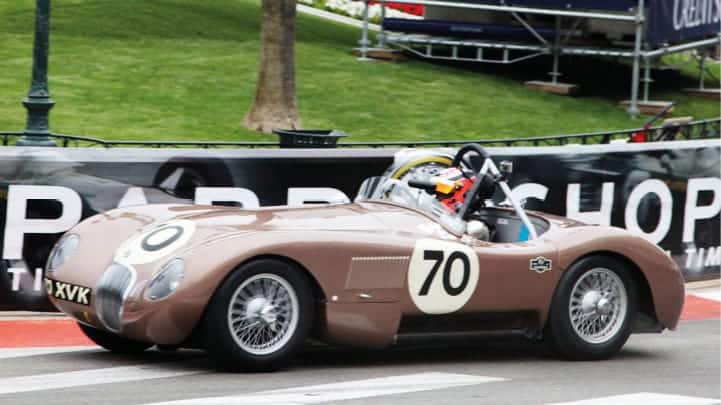
Button’s Jaguar C-type
Jaguar

Button made his historic racing car debut at the Revival last year, which included driving this AC Cobra in the TT
JOHN NGUYEN
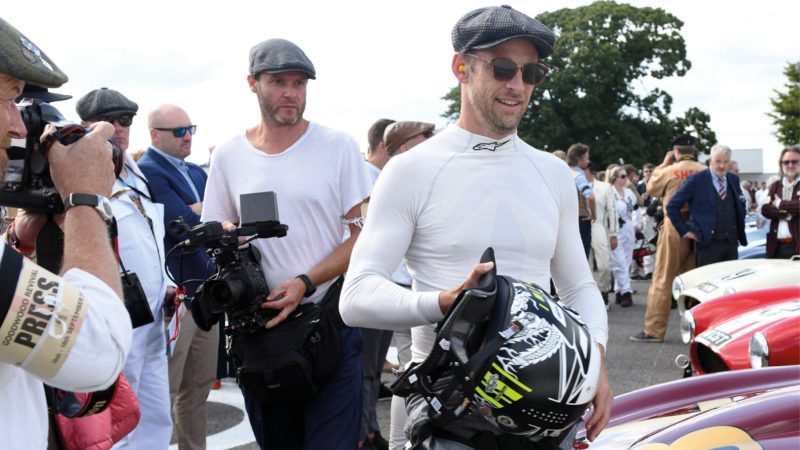
Have we seen the last of Button racing at the top? Maybe not… If there’s a drive at Le Mans or NASCAR he’s interested
Alamy
